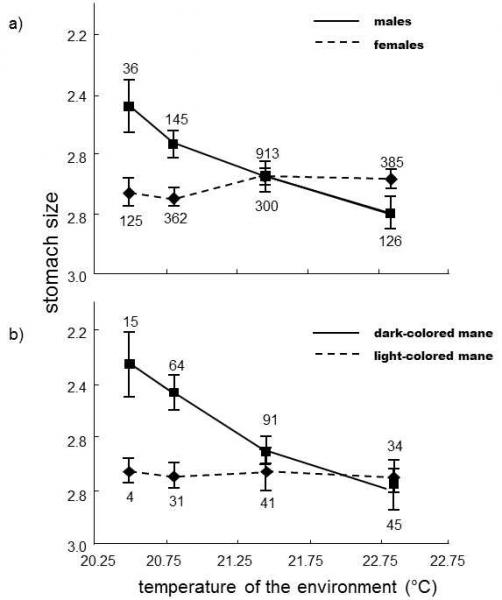XV.5.5.3 The degree of expression of secondary sexual traits can reflect the quality of ontogenesis of the given individual
Secondary sexual traitsvery frequently correspond to very complicated body structures, either three-dimensional (organs) or two-dimensional (patterns on the surface of the body). Their formation is apparently the result of a great many genes engaged in controlling the formation and development of other traits (i.e. genes with pleiotropic effect) (Mallet, Jiggins, & Mcmillan 1996). This means that the degree of expression of secondary sexual traits can reflect the progress of ontogenesis of the given individual. In individuals in which ontogenesis occurs with difficulty for some reason and in which various, although hidden developmental defects can be expected, the secondary sexual traits will be affected to the greatest degree.

Fig. XV.8 Absence of heredity of secondary sexual traits in sparrows. The size of the black spot on the chest is an important secondary sexual trait in house sparrows (Passer domesticus). The size of this spot is positively correlated with the position of the individual in the social hierarchy and simultaneously with his attractiveness for females. There is a positive correlation between the size of these spots in fathers and sons. In an experiment, eggs were exchanged amongst 87 nests (always the whole batch) and the correlation between the size of the spot on males and that of their genetic father (a) or step-father (b) was measured. It is apparent from the graph that the size of the spot on the genetic father has no effect on the size of the spot in a son for which he did not provide care, while the size of the spot of the son and the size o the spot of the step-father was positively correlated. According to Griffith et al. (1999).
In this connection, consideration is most frequently given to the preference for males with symmetrical structures and patterns, which has been observed in the females of some animal species (Swaddle & Cuthill 1994; Koehler, Rhodes, & Simmons 2002). Two types of asymmetry can be identified in organisms:systematic asymmetry, which is functional, generally genetically determined and apparently develops as a result of the action of natural selection (e.g. asymmetry in the strength and size of claws in crabs, asymmetry of the sex organs in insects, location of the heart in the chest cavity of mammals) and fluctuation asymmetry, which is not generally determined genetically and has unsystematic character (in some individuals the right-hand side predominates, in others the left-hand side and others can be completely symmetrical). It is assumed that fluctuation asymmetry is formed as a consequence of disorders and unevenness in the ontogenesis of the individual, so that its degree reflects the quality of ontogenesis (van Valen 1998).
Whether and how well body asymmetry can function as an indicator of the quality of ontogenesis remains, at the very least, a matter for conjecture (Rasmuson 2002). For example, studies performed on humans have demonstrated that persons with natural asymmetry of their faces were considered more beautiful (Swaddle & Cuthill 1995). If test persons were shown the original photographs of unknown persons and photographs of the same people in which natural asymmetry was removed by a computer, the unmodified photographs were considered more beautiful. On the other hand, a number of works exist in which the preference for symmetry in humans is experimentally demonstrated (Thornhill, Gangestad, & Comer 1995; Singh 1995).
The hypothesis of indicators of the quality of ontogenesis can be included either amongst direct benefit hypotheses or amongst good genes hypotheses. The quality of ontogenesis can be affected by the quality of the individual genes, external factors and the quality of the entire genome, i.e. mutual compatibility of the individual genes in the genome. It should be realized that especially the latter factor can substantially affect the result of ontogenesis. In sexually reproducing organisms, the quality of the genome is not inherited in the true sense of the word, as the genome of the individual is formed in each generation by random mixing of the genes derived from both parents (see IV.9).
